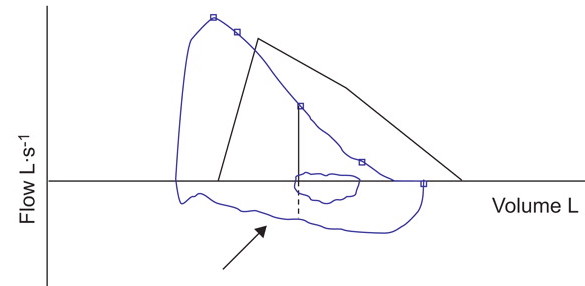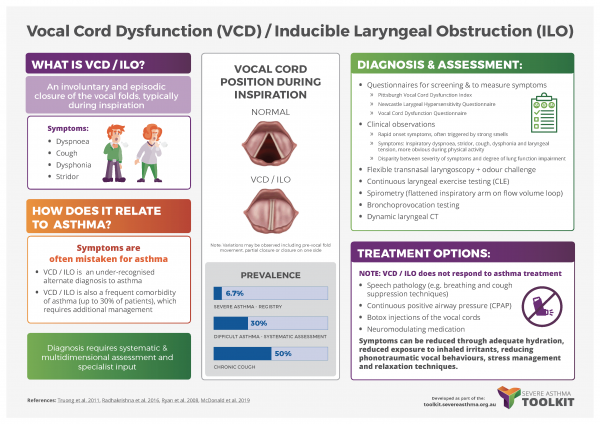The experience of VCD symptoms:

“I am getting a lot of spasms…and it’s really difficult”
Video provided by Dr. Joy Lee, Alfred Hospital, with permissions.
Vocal Cord Dysfunction Definition:
Vocal Cord Dysfunction (VCD) can be defined as “involuntary and episodic closure of the vocal folds during inspiration which leads to symptoms of dyspnea, cough, dysphonia, and stridor”. Vocal Cord Dysfunction has been referred to by many different names in the literature. It is commonly referred to as “paradoxical vocal fold movement” (PVFM) or “inducible laryngeal obstruction (ILO)”. VCD is part of the spectrum of dysfunctional larynx which includes chronic cough, muscle tension dysphonia and globus pharyngeus.
VCD usually occurs during inspiration, but may also occur during expiration. It may be accompanied by a sensation of choking and suffocating, throat or chest tightness. Symptoms are often triggered quickly and resolve quickly once the triggering stimulus is removed.
VCD should be considered when other respiratory causes for symptoms are excluded or are insufficient to explain the severity of the condition.
Differential diagnosis includes: asthma, anaphylaxis, laryngeal spasm and subglottic stenosis.
- In contrast with asthma, symptoms in VCD are often localised to the larynx, there is more difficulty with inspiration than expiration, and onset and resolution of dyspnoea episodes is rapid rather than sudden. VCD may co-exist with asthma or may be misdiagnosed as asthma. Symptoms of VCD can mimic asthma leading to an incorrect diagnosis of asthma and escalating treatment of asthma including inhaled and systemic corticosteroids.
- Subglottic stenosis usually results in increased symptoms during exercise.
- Voice symptoms can occur in asthma in the absence of VCD.
- VCD commonly co-occurs in chronic cough (Shembal et al. 2017).
Classification:
There is no universal agreement on the definition or diagnosis of VCD and no standardised classification system. Some common subtypes described in the literature are:
- Idiopathic
- Co-occurring with chronic refractory cough
- Exercise induced (Newsham et al. 2002)
- Irritant induced (Perkner et al. 1998)
- Psychological stress-induced
Further research is needed to determine classification criteria and develop agreement on definition and diagnosis (Shembal et al. 2017).
Prevalence:
The prevalence of VCD is difficult to estimate. It varies between studies and depends on the study population and setting.
- VCD has been reported in:
- 50% of patients with chronic cough (Ryan et al. 2008)
- 3-5% of patients with severe asthma (Kenn et al. 1997 AJRCCM)
- Up to 30% of patients with difficult asthma (Radhakrishna et al. 2016)
- 5-22% of patients requiring emergency care for dyspnea (Jain 1997)
- 15% of US recruits assessed for asthma (Morris et al. 2002)
- 5% of US Olympians (Rundell et al. 2003)
- Some literature suggests female predominance (2:1), and is also recognised in people with high levels of irritant exposure, elite athletes, and some military personnel (Morris et al. 2013).
- Further research is needed.
Diagnosis:
- Questionnaires (For more information see Resources – Comorbidity Components)
Pittsburgh Vocal Cord Dysfunction Index
The PVCDI assesses symptoms of throat tightness, dysphonia, absence of wheeze and triggering by odours as key features that differentiate VCD from asthma. A score ≥4 indicates a diagnosis of VCD (Traister et al. 2014).
Dyspnoea Severity Index
To assess upper airway symptoms and treatment follow-up (Gartner-Schmidt et al. 2014). Score > 10 suggestive of abnormal upper airway dyspnea. Good reliability and discriminant validity reported, but has not been reported as a diagnostic tool and not specific for VCD. For access email: gartnerschmidtjl@upmc.edu
Newcastle Laryngeal Hypersensitivity Questionnaire (LHQ)
For the identification of laryngeal dysfunction and to monitor response to treatment (Vertigan et al. 2014). A score of <17.1 is suggestive of abnormal laryngeal function.
Download the LHQ and accompanying Questionnaire worksheet here.
Vocal Cord Dysfunction Questionnaire
A symptom monitoring tool which is sensitive to changes in speech therapy (Fowler et al. 2015). A higher score indicates a higher probability of VCD, but has not been tested as a diagnostic questionnaire. The VCDQ can be downloaded here for clinical and research use. For additional permissions email: sj_fowler@hotmail.com
Other scales
To assess associated symptoms such as cough (Leicester Cough Questionnaire (Birring et al. 2003)) and dysphonia (Voice Handicap Index (Jacobson et al. 1997)).
- Clinical observations include inspiratory dyspnoea, stridor, cough, dysphonia, and tension in the laryngeal region. These symptoms may be absent during quiet breathing but more obvious during physical activity or voice testing. There may be a disparity between pulmonary function testing and symptoms. For example, a patient may have normal baseline spirometry (FEV1, FVC, FEV1/FVC ratio) in the presence of symptoms of breathlessness. Inhaled bronchodilators are frequently ineffective in relieving symptoms or only effective if used in large doses (e.g. 6-8 puffs at a time).
- Objective tests:
Flexible transnasal laryngoscopy
Laryngoscopy allows visualisation of the vocal folds during quiet respiration, phonation, exercise and during odour challenge. It is best when combined with a provocation challenge. Closure (either full or partial) of the true vocal folds is observed during inspiration and may occur more than 50% on expiration. Supraglottic structures such as the false vocal folds may also demonstrate medial and/or anterior/posterior constriction. The larynx may appear normal at rest and provocation through irritant exposure or exercise is needed to observe symptoms (Halvorsen et al. 2017).
The videos below are of flexible transnasal laryngoscopy demonstrating A) normal and B) paramedian vocal folds during expiration, suggestive of VCD.
Flow volume curve
Typically shows normal expiratory flow, but the inspiratory limb of the flow volume loop may be flattened. May also indicate a reduction in FIF50 of >20-25% (Sterner et al. 2009, Kenn et al. 2011).
Bronchoprovocation tests
Using hypertonic saline, methacholine or mannitol. Mannitol has been reported as both a laryngeal provocation agent and bronchial provocation challenge agent in a small case series. The relationship between bronchoprovocation testing and VCD is complex and not completely understood (Tay et al. 2017).
320-slice computed tomography (CT) larynx
Allows dynamic images that can be reconstructed to visualise movement of the anatomical structure (Ruane et al. 2014).
Performing a Transnasal Laryngoscopy (Video developed with Dr. Anne Vertigan, John Hunter Hospital)
A step-by-step demonstration of a flexible transnasal laryngoscopy including a scent challenge, to inform a diagnosis of vocal cord dysfunction. Includes a brief overview on patient history, purpose of procedure and discussion of results with the patient. For more information click here.
Representative Video of Flexible Transnasal Laryngoscopy (Videos provided by Dr. Joy Lee, Alfred Hospital)
Representative Flow Volume Loop

Representative flow volume loop with flattened inspiratory curve (black arrow) following methacholine challenge. Reproduced with permission from the ©ERS 2018. European Respiratory Journal Jan 2011, 37 (1) 194-200; DOI: 10.1183/09031936.00192809 (Kenn et al. 2011).
Treatment:
- Speech pathology treatment is the mainstay of intervention. It contains several components including:
- Education on what VCD is, how it coexists with asthma and why it needs a different approach to asthma treatment
- Reducing laryngeal irritation by reducing exposure to laryngeal irritants, desensitisation, hydration and reducing phonotraumatic vocal behaviours (Boris et al. 2002)
- Symptom control exercises such as PVFM release breathing. Exercises are timed with asthma medication.
- Psychoeducational counselling
- Inspiratory muscle training
- Treatment of co-existing laryngeal issues such as cough, globus and dysphonia
- Continuous positive airway pressure (CPAP) lowers expiratory flow and increases lung volume, opening the glottis to relieve dyspnea. CPAP also reduces the effort required for inspiration by establishing a favourable pressure gradient for inhalation (Shin et al. 2016).
- Botox injections into the vocal folds prevents release of acetylcholine at nerve terminals, with use previously demonstrated for the management of dystonias. Effects of injections may last up to 14 weeks (Perez et al. 2012).
- Neuromodulating medication, such as pregabalin and gabapentin has been reported in the chronic cough literature (Ryan et al. 2012, Vertigan et al. 2016) and has been used to treat VCD where laryngeal hypersensitivity is suspected. More research is required to determine effectiveness in VCD.
Summary:
- Vocal cord dysfunction is an important comorbidity in asthma. It can mimic asthma leading to inappropriate escalation in asthma treatment.
- Vocal cord dysfunction should be considered as a differential diagnosis or co-morbid in patients with severe asthma.
- Speech pathology treatment is effective in relieving symptoms.
Last Updated on

